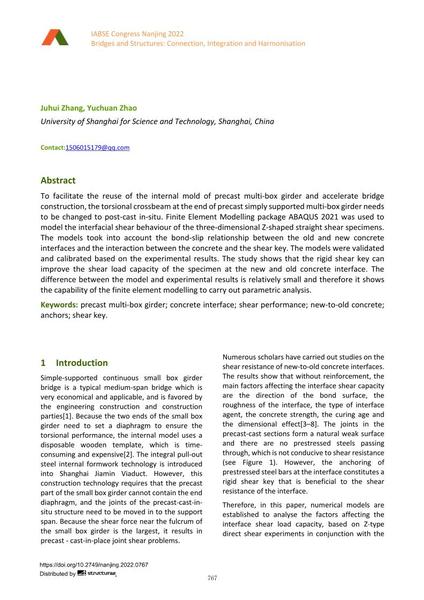FE Modeling of the Interfacial Behaviour of Precast Multi-box Girder

|
|
|||||||||||
Détails bibliographiques
| Auteur(s): |
Juhui Zhang
(University of Shanghai for Science and Technology, Shanghai, China)
Yuchuan Zhao (University of Shanghai for Science and Technology, Shanghai, China) |
||||
|---|---|---|---|---|---|
| Médium: | papier de conférence | ||||
| Langue(s): | anglais | ||||
| Conférence: | IABSE Congress: Bridges and Structures: Connection, Integration and Harmonisation, Nanjing, People's Republic of China, 21-23 September 2022 | ||||
| Publié dans: | IABSE Congress Nanjing 2022 | ||||
|
|||||
| Page(s): | 767-776 | ||||
| Nombre total de pages (du PDF): | 10 | ||||
| DOI: | 10.2749/nanjing.2022.0767 | ||||
| Abstrait: |
To facilitate the reuse of the internal mold of precast multi-box girder and accelerate bridge construction, the torsional crossbeam at the end of precast simply supported multi-box girder needs to be changed to post-cast in-situ. Finite Element Modelling package ABAQUS 2021 was used to model the interfacial shear behaviour of the three-dimensional Z-shaped straight shear specimens. The models took into account the bond-slip relationship between the old and new concrete interfaces and the interaction between the concrete and the shear key. The models were validated and calibrated based on the experimental results. The study shows that the rigid shear key can improve the shear load capacity of the specimen at the new and old concrete interface. The difference between the model and experimental results is relatively small and therefore it shows the capability of the finite element modelling to carry out parametric analysis. |
||||
| Mots-clé: |
mouillages
|
||||
| Copyright: | © 2022 International Association for Bridge and Structural Engineering (IABSE) | ||||
| License: | Cette oeuvre ne peut être utilisée sans la permission de l'auteur ou détenteur des droits. |
||||
